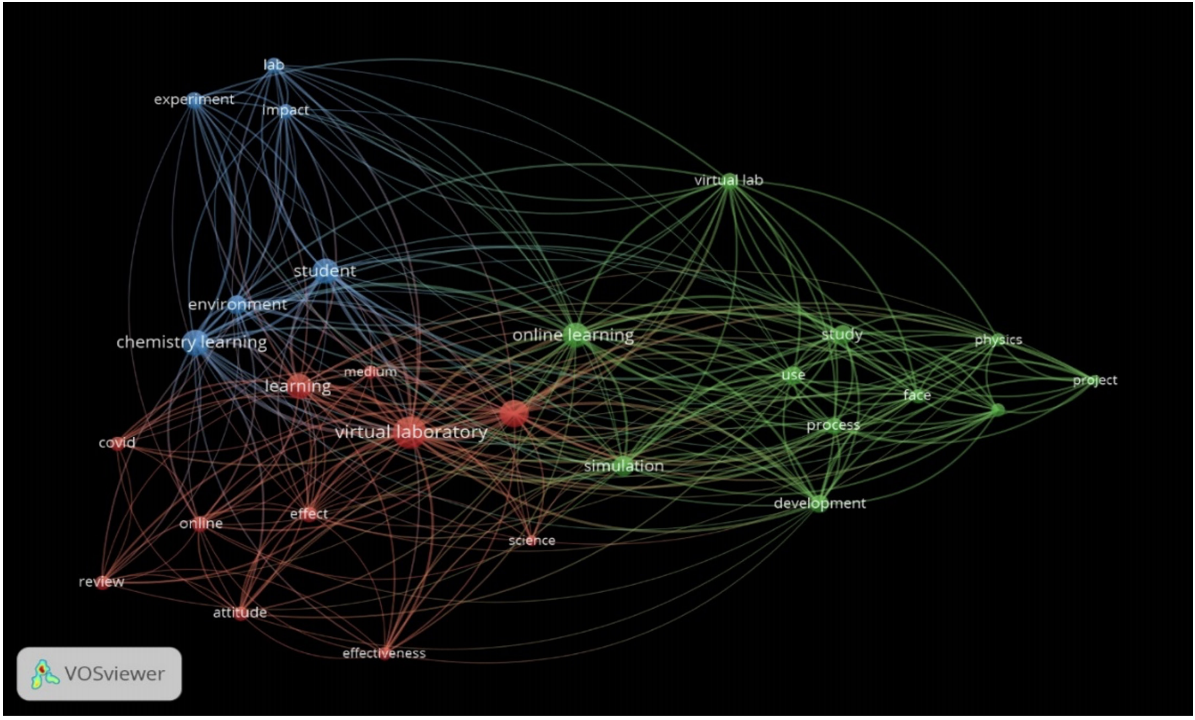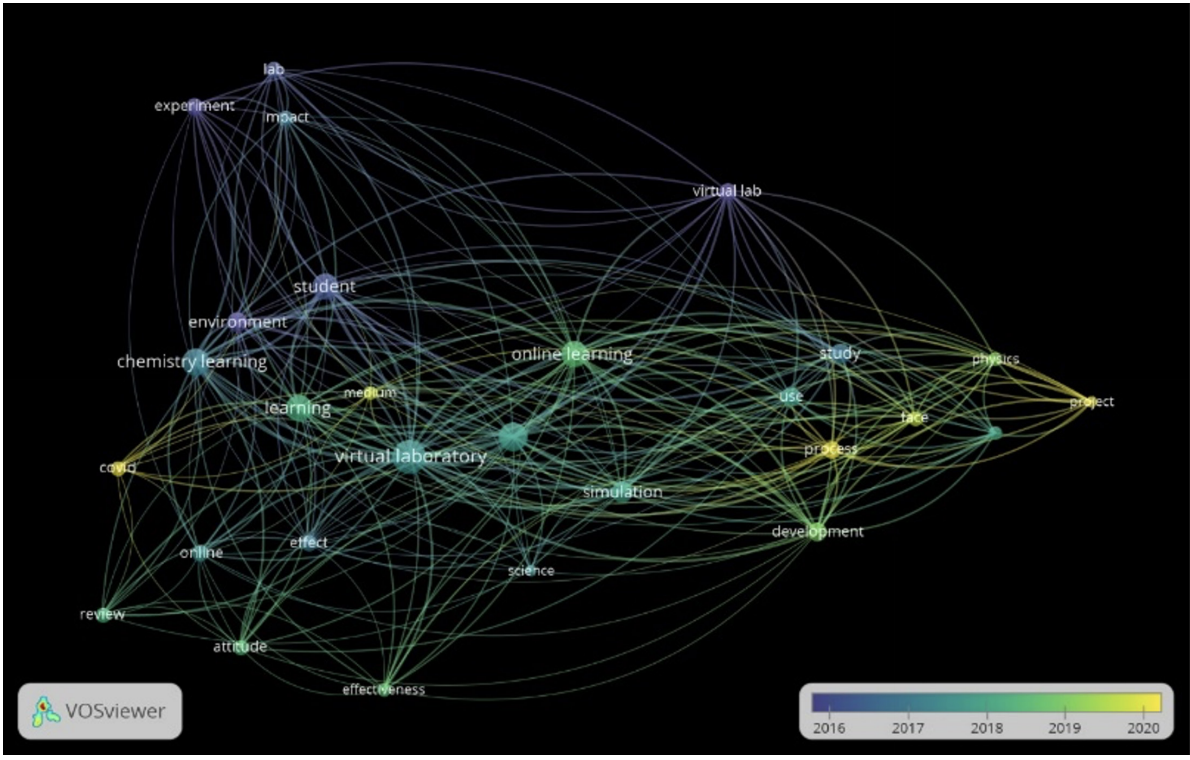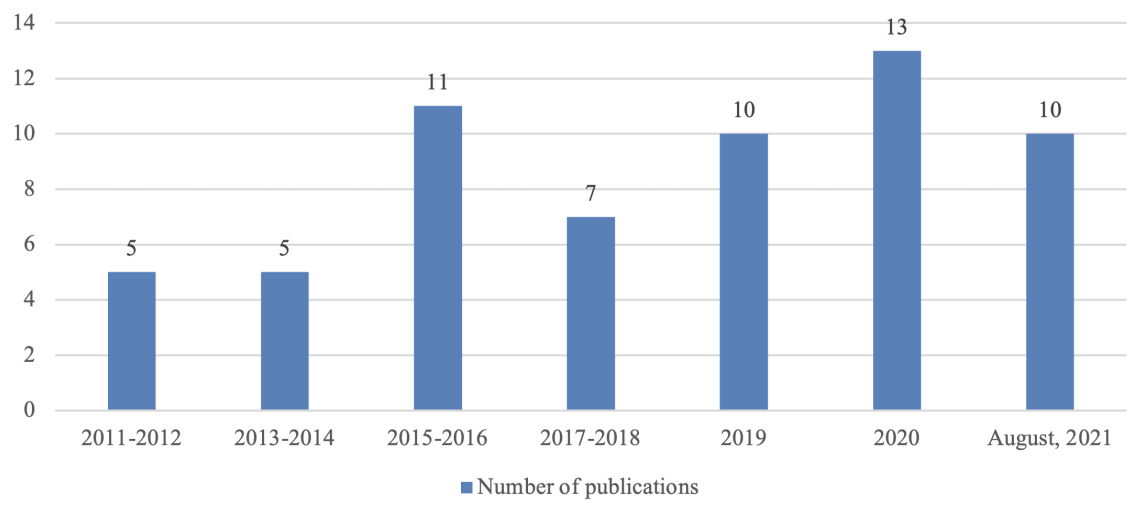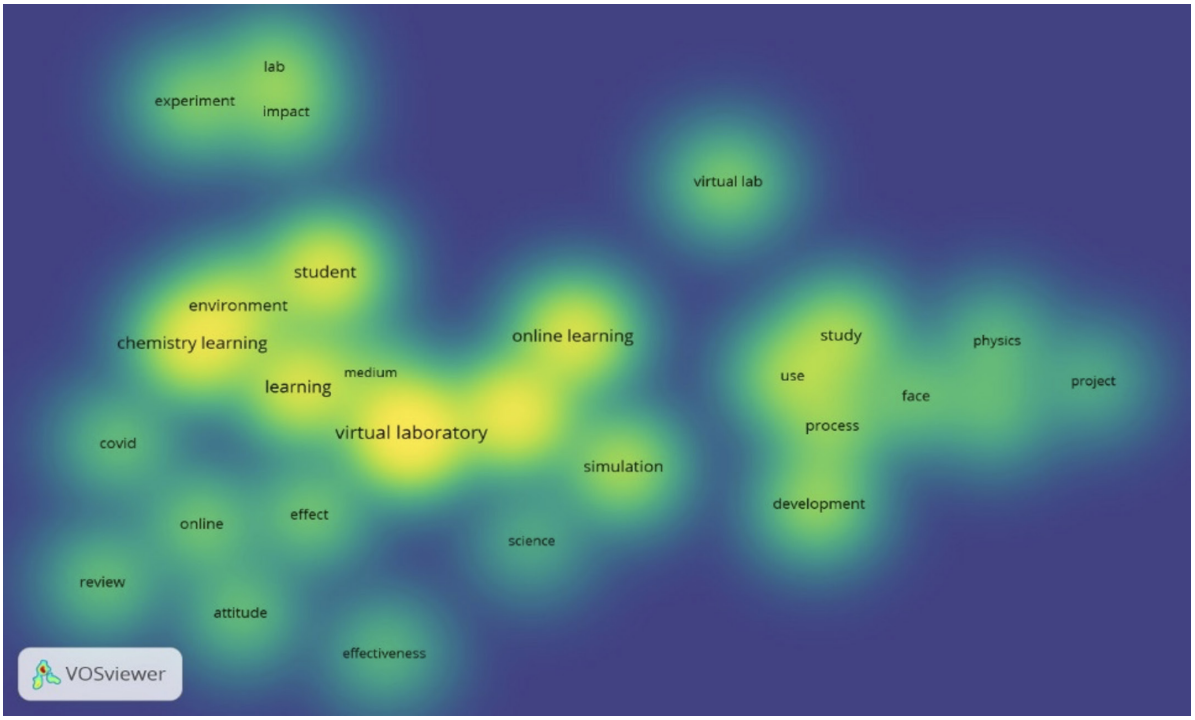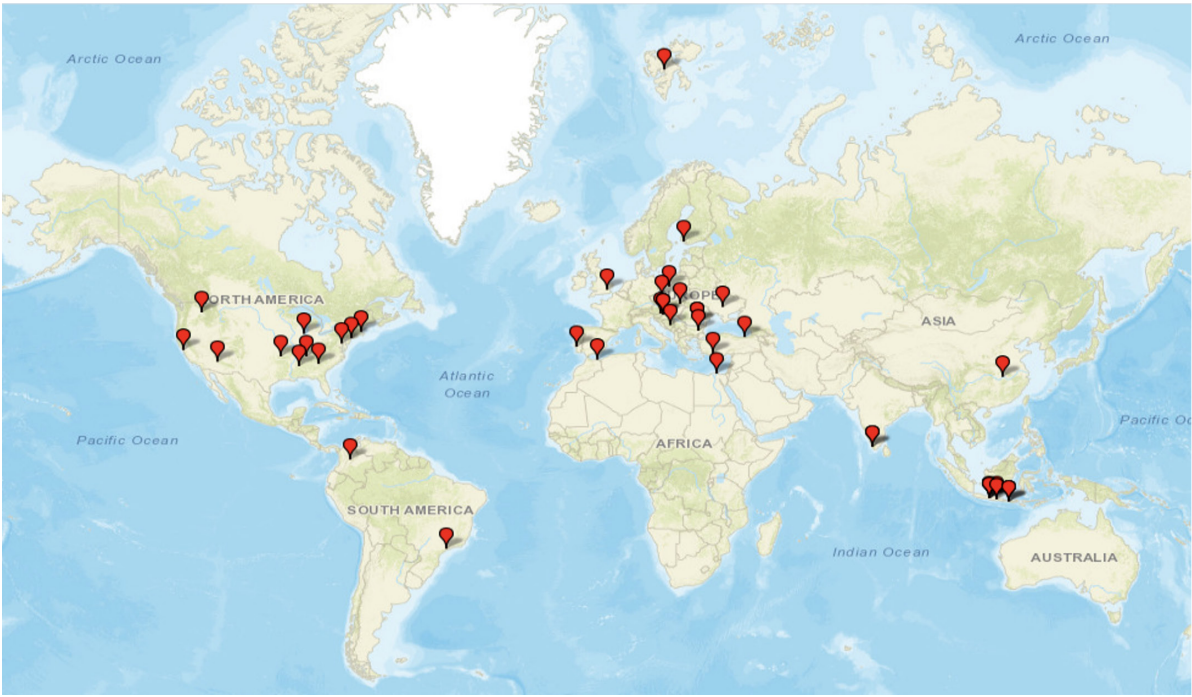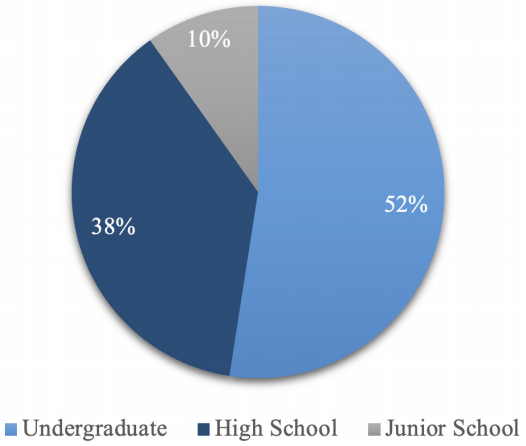Introduction
Chemistry learning should be able to integrate contextual chemistry problems from the real world, train the thinking skills needed, and present the sophistication of 21st-century learning technology (Griffin, McGaw, & Care, 2015; Shidiq & Yamtinah, 2019; Trilling & Fadel, 2010). In online chemistry learning during the COVID-19 pandemic, the use of technology to present contextual learning is a major need (Fuad, Ariyani, Suyanto, & Shidiq, 2020; Juanda, Shidiq, & Nasrudin, 2021; Shidiq, Permanasari, Hernani, & Hendayana, 2021b.
Many studies have developed and integrated technology in chemistry learning, such as the use of online video tutorial technology in analytical chemistry learning (He, Swenson, & Lents, 2012), digital animation in high school (Al-Balushi, Al-Musawi, Ambusaidi, & Al-Hajri, 2017; Musawi, Ambusaidi, & Al-Balushi, 2015), and Virtual Laboratory technology including Virtual Reality and Augmented Reality (Macariu, Iftene, & Gîfu, 2020; Naese et al., 2019; Ovens, Ellyard, Hawkins, & Spagnoli, 2020). A virtual laboratory is widely used because not all chemical materials can be explained through lab experiments. Some material characteristics tend to be submicroscopic, so it is not easy to explain in a real laboratory (Faulconer, Griffith, Wood, Acharyya, & Roberts, 2018). In learning chemistry, macroscopic, sub-microscopic, and symbolic representations should be understood. However, most teachers only explain in class without visually showing the relationship between these three levels so that students do not understand these materials (Ali, 2012; Redhana, Sudria, Hidayat, & Merta, 2017).
Therefore, learning media that can accommodate the multiple linkages of chemical representations is needed (Habig, 2020; Irby, Borda, & Haupt, 2018; Widarti, Rokhim, & Muchson, 2021). A virtual laboratory is an answer to these problems. Visualization is essential in connecting the macroscopic, submicroscopic, and symbolic levels while the virtual laboratory is an appropriate tool in achieving visualization (N. A. R. Herga, GlaŽar, & Dinevski, 2015). This is reinforced by research results that show promising results when chemistry learning using a virtual laboratory is applied at the primary school level (N. A. R. Herga et al., 2015; N. R. Herga, Cagran, & Dinevski, 2016; Nuić & Glažar, 2020).
In addition, research related to virtual laboratories has been carried out considering the function of virtual laboratories that can help students understand abstract concepts from chemistry (Amin & Ikhsan, 2021; Nuić & Glažar, 2020; Salame & Makki, 2021; Saputro, Saerozi, & Ardhiansyah, 2020). Several studies reveal that virtual laboratory implementation contributes to students’ meaningful learning by enabling the concretization of abstract subjects. These applications positively support students’ interest, excitement, and motivation for the science course because they are attractive (Penn & Ramnarain, 2019; Yildirim, 2021). The use of virtual laboratories has become an increasing issue regarding science laboratories due to the increasing cost of hands-on laboratories and the increase in distance education (Hadisaputra, Ihsan, Gunawan, & Ramdani, 2020).
Although virtual laboratories cannot wholly replace actual experiments, they can be an effective complementary tool (Hawkins & Phelps, 2013; H. Ramos & Nieto, 2016). A series of limitations, such as health, safety, and lack of equipment, are obstacles to carrying out practical activities in the school laboratory (Kamaliya, Fibonacci, & Azizati, 2020). These can be minimized using virtual laboratories with several advantages over physical laboratories. The advantage is that it allows for expensive and dangerous experiments, and observations that occur too quickly or too slowly in the real world can be observed through a virtual laboratory. Students can observe or simulate chemical experiments that are difficult to implement in the classroom, where observation or measurement is not facilitated, poses a health risk, or requires expensive supplies or equipment that are rarely available (Diwakar et al., 2015).
Virtual laboratories are not only used at the university level, which has a range of complex and abstract materials, but they are also used at the senior and junior high school levels to introduce chemistry to students (Abdel-Maksoud, 2018; S. Ramos, Pimentel, Marietto, & Botelho, 2016; Wijayanti, Sugiyarto, & Ikhsan, 2019). In addition, another study demonstrated the use of virtual labs in the role of dynamic visualization for a better understanding of chemistry in primary schools which showed promising results (N. A. R. Herga et al., 2015; N. R. Herga et al., 2016). This is one of the good effects of using a virtual laboratory and provides advantages for students and teachers in the future (Hillmayr, Ziernwald, Reinhold, Hofer, & Reiss, 2020; Nuić & Glažar, 2020).
Several studies discussing virtual laboratories show that this topic is an alternative learning media for a better learning process in chemistry education, especially during distance learning. A review of the extent of research and publications using this virtual laboratory is necessary to understand this domain better. Therefore, this study aims to provide a bibliometric literature review to analyze the literature on virtual laboratories. Furthermore, it analyzes the challenges and opportunities of using virtual laboratories for teaching and learning purposes. It is hoped that this study can be a reference for further insights and research opportunities in the field of virtual laboratories in chemistry education.
Methodology
Research Design
The bibliometric literature review method was used in this study to highlight the development of a virtual laboratory in chemistry education. Five stages of research were used to conduct a systematic review and obtain valid data (Garza-Reyes & Arturo, 2015; Hudha et al., 2020; Mulyawati & Ramadhan, 2021; Shidiq, Permanasari, Hernani, & Hendayana, 2021a). These stages are shown in Figure 1.
The following is a literature data processing stage.
1. Determining Keywords
In this study, general keywords were used, namely “chemistry learning” and “virtual laboratory” or “virtual lab”. These keywords were then used to obtain literature data in the Google Scholar database through the PoP 7 software (Publish or Perish 7).
2. Initial Literature Data Mining
The initial data mining was done with Publish or Perish (PoP) Software. This software can be downloaded for free (https://harzing.com/resources/publish-or-perish/windows). The keywords above and the criteria for the year 2011-2021 were used in the data mining process. Based on these criteria, 117 articles were obtained. This software mines articles from the Google Scholar database. Further analysis of this data showed that a total of 772 citations were found in the articles obtained. This indicated that the articles were attractive to readers. In more detail, the results of data mining are shown in Table 1.
3. Literature Data Selection
The literature data selection was done manually by reading the article’s title related to the research topics. At the initial data mining results, a lot of literature was not under the research topic so that the articles were dropped and deleted. After going through the selection process, 61 relevant articles were obtained. The data matrix at this stage is shown in Table 2.
4. Final Data Mining
A total of 61 article titles obtained from PoP software were then downloaded from Google Scholar. This aimed to analyze the content of the article more deeply. Each article obtained was reviewed, including the chemistry topics and kinds of virtual labs. This is important to review for mapping research opportunities.
5. Literature Data Extraction and Analysis
Data extraction was completed using the VOSviewer software. VOSviewer is software for constructing and visualizing bibliometric networks. Those networks may also consist of journals, researchers, or character courses and be constructed based on citation, bibliographic coupling, co-quotation, or co-authorship family members. This software can be downloaded for free (https://www.vosviewer.com/). The analysis in this study focused on the keyword network visualization, overlay visualization, virtual laboratory development sites, types of virtual laboratories, chemistry topics, and level of education.
Results and Discussion
Visualization Topic Area of Virtual Laboratory in Chemistry Education
After the literature dataset was analyzed using VOSviewer, 3 clusters (red, green, and blue) were obtained. Based on the data from the VOSviewer analysis, bibliometric mapping was obtained in three different visualizations, namely network visualization (Figure 2), overlay visualization (Figure 3), and density visualization (Figure 5). The three visualizations show the relationship of keywords that often appear from 61 articles.
The results of the network visualization are shown in Figure 2 with three color clusters. The first cluster in blue is the chemistry learning cluster which consists of 6 keywords. The blue group reflects research that emphasizes the object and content under study; the keyword shown is “chemistry learning and students”. The second cluster in red is the virtual laboratory cluster with 11 keywords. The red group reflects the research variable. This data is denoted by the keywords “virtual laboratory, attitude, effectiveness, and COVID”. The last cluster in green is the online learning cluster with 11 keywords. The green group reflects the media and methods used, indicated by “virtual laboratory, simulation, and project”.
Figure 2 shows that COVID, online learning, and virtual laboratory are in the same cluster (red area). This shows that there is a close relationship between them. This happened because of the demand for online learning and virtual labs during the COVID-19 pandemic to support the chemistry learning process (Mahaffey, 2020). The size of the circles and letters in the network visualization indicates the frequency of occurrences. The larger the circle size and visible letters, the more these keywords appear in the literature. It appears that the words “virtual laboratory, online learning, chemistry learning, and student” have a larger circle and letter than other words. Thus, these words can be used as current topics to be researched until 2021.
Figure 3 shows an overlay visualization. This map analyzes trends from year-to-year related research on virtual laboratories in chemistry education. The yellow circles indicate the latest research trends from 2020 to 2021. From Figure 3, “project, COVID, and process” are keywords that often appear in current research. The development of online learning and virtual laboratory research is increasing during the COVID-19 pandemic due to the limitations of teachers in conducting physical experiments (Buchberger, Evans, & Doolittle, 2020; Widarti et al., 2021). This is following the results found from 61 articles in this study. In general, the number of publications from 2020 to 2021 about virtual laboratories in chemistry learning tends to increase compared to that in the year before the pandemic. These data are shown in Figure 4.
Teachers are required to do online learning during the pandemic, so they have to find other ways to keep the material delivered according to the existing chemistry curriculum (Buchberger et al., 2020; Shidiq et al., 2021b) such as laboratory activities. A virtual laboratory can be used by chemistry teachers in their classrooms (Hawkins & Phelps, 2013; Ponce Gallegos, Ornelas Zapata, Muñoz Arteaga, & Esquivel Arellano, 2019).
Based on Figure 3, the making of virtual laboratory learning projects is currently carried out by researchers and teachers during the pandemic as one of the learning methods in the chemistry class. Other researchers have also proven that the use of technology can bridge the learning vacuum for students during the COVID-19 (Hamidah, Sriyono, & Hudha, 2020; Kartimi, Gloria, & Anugrah, 2021; Lestiyanawati & Widyantoro, 2020). Therefore, teachers must teach the mastery of technology other than content and pedagogy during online learning (Babinčáková & Bernard, 2020; Giri & Dutta, 2020; Ari Syahidul Shidiq et al., 2021b).
The density visualization in Figure 5 shows the number of keywords that appear in the article. Bolder yellow color means that these keywords are more often found in the article. Based on the selected 61 articles, the keywords “virtual laboratory, online learning, chemistry learning, and student” have high density. Further analysis, the use of virtual laboratories in chemistry learning is increasing from year to year which may be due to the demand for 21st-century learning that emphasizes technology used in learning (Pence, Williams, & Belford, 2015; A. S. Shidiq & Yamtinah, 2019). The virtual laboratory was used before, during, and probably after the COVID-19 pandemic.
Author Affiliation Mapping
The extracted literature data was then analyzed for the author’s affiliation using GPS Visualizer (https://www.gpsvisualizer.com/) (Hudha et al., 2020). GPS Visualizer is an online utility that creates maps and profiles from geographic facts. The tool is free to use, smooth, and customizable. The analysis results are shown in Figure 6 with 37 points from the first author’s affiliation. This number includes institutions from several continents. In general, research related to virtual laboratories in chemistry seems to have been developed in the central part of Europe, where the dots appear to be converging. However, of the selected 61 articles, not many researchers from the Asian, African, and Australian regions have used virtual laboratories in chemistry education. This can be a research opportunity that needs to be explored with more comprehensive content, in terms of chemistry topics and the virtual laboratory technology used.
Pedagogical Aspect
The use of virtual laboratories in chemistry education cannot be separated from the pedagogical aspects, including learning methods, chemistry topics, and educational levels. Based on the analysis, before the COVID-19 pandemic, virtual laboratories became an alternative practicum method to increase student interest in chemistry (Cai, Wang, & Chiang, 2014), teach abstract concepts (Crandall et al., 2015; Irby et al., 2018), and save budget on tools and materials (Georgiou, Dimitropoulos, & Manitsaris, 2007). However, during the pandemic that requires online distance learning, virtual laboratories become a necessity. Students cannot do practical work in the laboratory and can only do simple chemistry practicum at their homes (Kolil & Muthupalani, 2020; Mahaffey, 2020). Virtual laboratory with its various forms enables online practicum (Kennepohl, 2021).
In early 2020 when the COVID-19 pandemic began to spread, all existing fields, especially education, began to adjust. Chemistry learning which essentially requires practical activities with natural objects was also adjusted and changed (Erduran, 2020). The use of technology in chemistry practicum, including virtual laboratories, is an alternative method for teachers and researchers to deal with learning during the pandemic. This has the advantage of allowing students to explore the content of science and technology in its application; it can also train critical thinking skills in solving a problem and creativity in designing science and technology (Saputro et al., 2020).
Virtual laboratories developed in the last ten years have various types and topics. Table 3 shows the variation of these aspects. Several studies have developed a gaming-based virtual laboratory (Shudayfat et al., 2015; Stefan & Moldoveanu, 2015). Virtual games are proven to be an excellent educational tool as they allow the users to visualize, explore, manipulate, and interact with objects and information in a computer-generated environment (Shudayfat et al., 2015).
Table 3 Types and Topics in the Developed Virtual Laboratory.
| No | Type of Virtual Laboratory | Chemistry Topic | Authors |
|---|---|---|---|
| 1 | LabLife3D the virtual learning environment | Microbiology and organic chemistry | (Qvist, 2015) |
| 2 | Education Information Network and the PhET web page | Matter, its characteristics and changes, and pure substances and mixtures. | (Yildirim, 2021) |
| 3 | Virtual Reality (VR) | Chemical bonding | (Astuti, Sugiyarto, & Ikhsan, 2019) |
| 4 | Gamified 3D virtual learning environment designed | Acid and base reaction | (Shudayfat, Moldoveanu, Moldoveanu, Grэdinaru, & Dascэlu, 2015) |
| 5 | VirtuaLabQ integrated to hands-on laboratory | Chemical Transformations | (S. Ramos et al., 2016) |
The chemistry topics developed into a virtual laboratory also vary widely, from the classification of substances to organic and inorganic chemistry. This indicates that the material is not necessarily difficult and complicated requiring explanations from a virtual laboratory, but a simple material such as substance classification can also create a virtual laboratory for junior high school students (N. A. R. Herga et al., 2015). The introduction of chemistry in junior high schools, especially using virtual laboratories, is still rare. This can be seen from the 61 reviewed articles where only 10% of the studies involve junior high school students as the subjects. Complete data on the education level of the research subject is presented in Figure 7.
Figure 7 shows the dominant level of education using virtual laboratories is the university level. Virtual laboratory learning can still be carried out at lower levels. For the current situation in the COVID-19 pandemic, senior and junior high school students are required to participate in technology-based learning such as virtual laboratories. The mastery of technology is a prerequisite for the students to participate in online learning activities. Therefore, educators and researchers can expand research related to virtual laboratories in other subjects that require practical activities.
Conclusion
Many virtual laboratories have been developed to overcome the limited physical practicum in the laboratory. Based on the overlay visualization of this study, the current trend of virtual laboratory research is the use of virtual laboratories as student project assignments. In addition, based on the mapping of the affiliation of the first author of the study, this research is mostly done in America and Europe. This allows other regions to develop research in this field. Analysis of the types of virtual laboratories developed has varied from web-based to game-based. However, virtual laboratory learning is still mainly carried out at the university level, where the materials developed are quite complex. Meanwhile, virtual laboratories can still be used at lower levels, such as senior and junior high school, which can be further research opportunities.











 nueva página del texto (beta)
nueva página del texto (beta)


